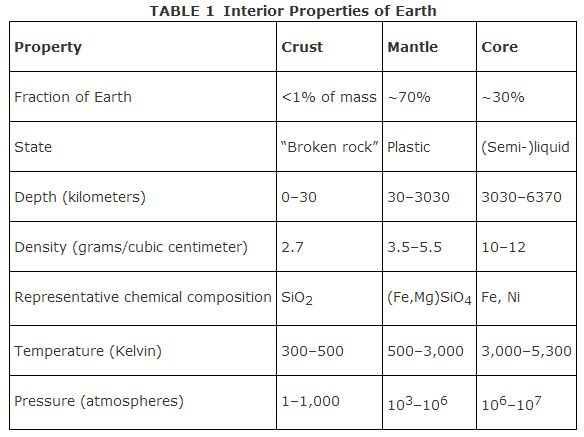Interior Structure: Core, Mantle, Crust
The interior of Earth is not subject to direct investigation, but its properties must be indirectly deduced from the study of earthquake waves that propagate through the interior rocks. From an earthquake near the surface, both pressure (compression) waves and transverse (side‐to‐side) waves move outwards in all directions. Wave energy moving into the interior, however, has its path slowly changed by refraction as the wave moves through regions of slowly changing properties. These waves reach the surface after a time that depends on the length of the path and the velocity of propagation at each point along that path. Careful analysis at seismographic stations of the time of arrival of earthquake waves over the surface of Earth yields information about the densities, temperatures, and pressures of Earth's interior. A thin crust (at its thickest only 30 kilometers deep), which contains the continental masses and the ocean floors, overlies a denser outer mantle. The uppermost layer of the mantle acts as solid material, a lithosphere no more than about 80 kilometers deep. Most of the mantle slowly flows under pressure and acts as a plastic, or malleable, asthenosphere.
In an annulus about the surface of Earth, opposite an earthquake, exists the shadow zone, in which you cannot observe pressure waves. The path of pressure waves is significantly affected by a sharp refraction that astronomers interpret as the point of transition between the mantle and an interior core that is substantially different from the outer part of the planet. The shadow zone for transverse waves, however, covers the whole of Earth opposite the earthquake source. No transverse wave energy apparently passes through the core, indicating that its physical state, in the outer regions at least, must be liquid. The innermost core, however, though at higher temperatures, is likely solid because of an even higher pressure there. As the center of Earth continues to slowly cool over time, this inner core must be slowly growing in size at the expense of the liquid outer core. Evidence also shows that this inner core is rotating faster than the rest of the planet, completing one full turn in two‐thirds of a second less time than at the surface. Applying other physical principles together with laboratory study of the nature of different materials under high temperature and pressure suggests the characterization of Earth's interior as shown in Table 1. (See Figure 1 for a diagram of Earth's interior.)


Figure 1
The interior of Earth.
Seismographic study of moonquakes has shown that the lunar structure is the same as the crust‐mantle‐core structure of Earth, with the significant differences being that the lunar mantle is primarily solid (the lunar lithosphere is about 800 kilometers deep and overlies only a shallow plastic asthenosphere), and the small iron core is frozen solid (see Figure 2). As the Moon's mantle and core continue to slowly cool, their materials shrink at different rates, producing stress at the core‐mantle interface; moonquakes thus occur in a deep spherical shell marking this interface. Because the Moon's outer mantle is frozen, unlike that of Earth, there is no interior convection, no surface plate tectonics, and no crustal quakes, other than an occasional tremor produced by the impact of a small meteor. In terms of interior structure, Earth and the Moon may be contrasted according to the information in Table 2.

Figure 2
The interior of the Moon.
|
|
|
|
|
|
|
|
|
|
|